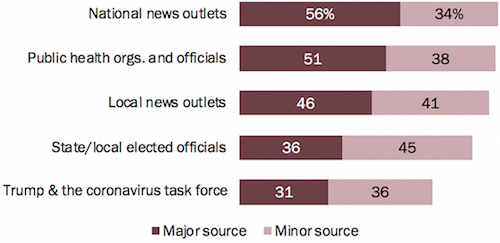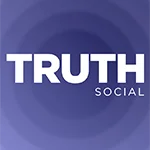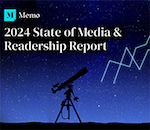The continuous flow of news and information regarding the COVID-19 pandemic continues to capture Americans’ rapt attention, but many of us are beginning to show signs of COVID-19 news fatigue, according to data analysis recently released by the Pew Research Center.
According to Pew’s survey, 71 percent said they now have to “take breaks” from COVID-19- related news, and nearly half (43 percent) reported that coronavirus news leaves them feeling worse emotionally.
Amid this constant news churn, half of Americans (50 percent) said they also often find it difficult determining what’s true and what’s false regarding the outbreak, and nearly two-thirds (64 percent) said they’ve seen at least some COVID-19 news and information that appeared to be fake.
 Americans’ preferred sources for COVID-19-related news. Americans’ preferred sources for COVID-19-related news. |
Nearly nine-in-ten Americans (87 percent) claim they’re following coronavirus-related news “very” or at least “fairly” closely, figures that remain, roughly, on par with findings from a previous Pew survey conducted in March (89 percent). More than half (56 percent) said national news outlets are a major source in getting that news, compared to 46 percent who primarily cited local outlets. About two-thirds (61 percent) of respondents said they give equal amounts of attention to both national and local sources when it comes to coronavirus news.
More than half (51 percent) also said they turn to public health organizations and officials for coronavirus-related news. Only about a third (36 percent) said state and local elected officials are a major source for them, and even fewer (31 percent) cited President Trump and the White House coronavirus task force as a major source for outbreak news.
Pew’s analysis was based on a survey of more than 10,100 U.S. adults drawn from its American Trends Panel, a nationally representative list of randomly selected respondents. Surveys were conducted between April 20-26.
Pew’s findings were compiled as part of the nonpartisan think tank’s Election News Pathways project, an ongoing initiative that examines how Americans are getting their news in the months leading up to the 2020 election.


 Trump Media & Technology Group today reported a $58.2M net loss on $4.1M in 2023 revenues, a disclosure that drove its stock price down 22.6 percent to $47.96.
Trump Media & Technology Group today reported a $58.2M net loss on $4.1M in 2023 revenues, a disclosure that drove its stock price down 22.6 percent to $47.96. Barry Pollack, an attorney at Wall Street’s Harris St. Laurent & Wechsler, has registered Julian Assange as a client with the Justice Dept. “out of an abundance of caution.”
Barry Pollack, an attorney at Wall Street’s Harris St. Laurent & Wechsler, has registered Julian Assange as a client with the Justice Dept. “out of an abundance of caution.” Paramount Global to slash 800 jobs in what chief executive Bob Bakish calls part of an effort to “return the company to earnings growth"... Rolling Stone editor-in-chief Noah Shachtman is exiting at the end of the month due to disagreements with chief executive Gus Wenner over the direction the magazine is taking... The New York Times broke the $1 billion barrier in annual revenue from digital subscriptions in 2023... Press Forward is investing more than $500 million to strengthen local newsrooms.
Paramount Global to slash 800 jobs in what chief executive Bob Bakish calls part of an effort to “return the company to earnings growth"... Rolling Stone editor-in-chief Noah Shachtman is exiting at the end of the month due to disagreements with chief executive Gus Wenner over the direction the magazine is taking... The New York Times broke the $1 billion barrier in annual revenue from digital subscriptions in 2023... Press Forward is investing more than $500 million to strengthen local newsrooms. The majority of news articles are read within the first three days of publication, according to a recent report.
The majority of news articles are read within the first three days of publication, according to a recent report. The Los Angeles Times gives pink slips to 115 people or 20 percent of its newsroom staff... TIME is also laying off about 30 employees, which is approximately 15 percent of its editorial staff... The Baltimore Banner, which was launched by Stewart Bainum in 2022 after he failed to buy the Baltimore Sun, added 500 subscribers per day in the three days following Sinclair Broadcast Group's deal to purchase the Sun.
The Los Angeles Times gives pink slips to 115 people or 20 percent of its newsroom staff... TIME is also laying off about 30 employees, which is approximately 15 percent of its editorial staff... The Baltimore Banner, which was launched by Stewart Bainum in 2022 after he failed to buy the Baltimore Sun, added 500 subscribers per day in the three days following Sinclair Broadcast Group's deal to purchase the Sun.


 Have a comment? Send it to
Have a comment? Send it to 
No comments have been submitted for this story yet.